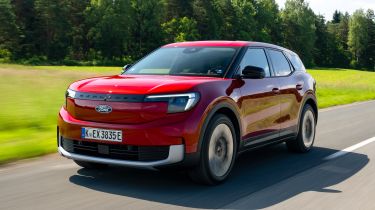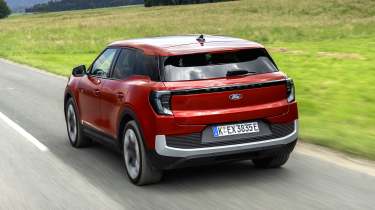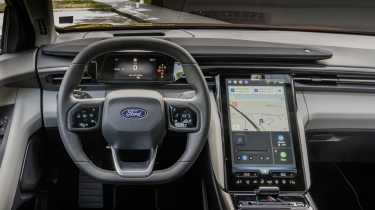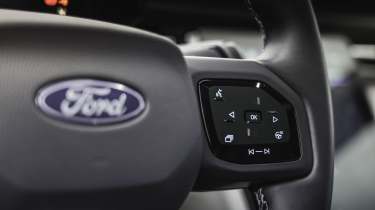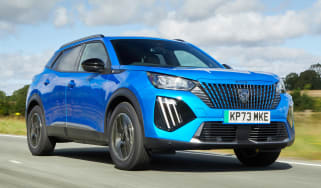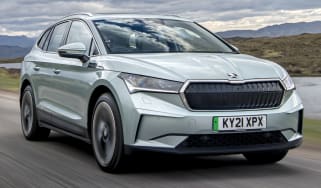Ford Explorer review
The Ford Explorer is loaded with kit, has decent efficiency figures and manages to stand out in a crowded electric SUV market
Pros
- Good efficiency figures
- Decent levels of equipment as standard
- Clever storage features
Cons
- Rival SUVs are cheaper
- Fiddly haptic switchgear
- Infotainment system isn’t perfect
| Range | Wallbox charge time | Rapid charge time |
| 331-374 miles | 7hrs 45mins (10-80%, 7.4kW) | 28mins (10-80%, 185kW) |
Ford Explorer verdict
Ford really needed to bring its A-game with the new Ford Explorer, especially since the electric SUV followed in the Mustang Mach-E’s footsteps, almost five years later. Ford might have borrowed the technical underpinnings from Volkswagen, but the Explorer still feels like a Ford product, and we mean that in a good way. It’s efficient, well-specced, good to drive and has some clever interior features – most importantly, it can hold its own in a crowded and competitive market. The Explorer is only let down slightly by its higher price tag and niggly infotainment system.
Details, specs and alternatives
Ford is a little behind the curve when it comes to its electric car offerings, with the Explorer being only the second proper production EV from the brand following Mustang Mach-E. There are those who will argue that the Ford Explorer is merely a re-styled version of the Volkswagen ID.4, thanks to Volkswagen’s MEB platform providing its underpinnings, and the car was also delayed by around nine months for battery tech improvements, so it’s fair to say that Ford’s EV SUV has some convincing to do. Thankfully, the long-awaited Explorer is an impressive mid-size SUV, with decent efficiency figures, a competent drive and a well-specced interior.
The Explorer comes with a choice of two trim levels. The higher-spec Premium trim is available on both rear and all-wheel drive cars, while the Select trim is only available on rear-wheel drive versions. Prices start from around £46,000 for the entry-level Explorer, ranging to almost £54,000 for the top-spec all-wheel drive Premium trim car. This is slightly higher than the Skoda Enyaq, and significantly more than you’ll pay for the Renault Scenic, although the Renault is a less powerful and less efficient car.
As standard, you get plenty of equipment. In entry-level Select cars there’s a 14.6-inch central touchscreen, 19-inch alloys, electric and heated front seats with a massage function, wireless phone charging and a range of driver safety equipment like lane-keep assist, adaptive cruise control and cross traffic alert. Move up to Premium spec and you’ll gain bigger 20-inch alloys, an uprated B&O audio system, a panoramic sunroof, matrix LED headlights and a powered tailgate. Premium spec adds around £4,000 onto the price tag of the rear-drive car. You will have to pay extra for a heat pump, as it doesn’t come as standard.
There are two battery choices available at launch, with the rear-driven model receiving a 77kWh battery pack, or a larger 79kWh battery for the top-of-the-range all-wheel drive version. Official range figures vary slightly depending on the car you choose. Entry-level rear-drive cars in Select trim return up to 374 miles on a single charge, dropping to 355 miles if you move up to the Premium trim, while all-wheel drive cars have an official range of 331 miles. The rear-wheel drive car we drove managed to return 3.6 miles per kWh, which would result in around 280 miles of real world range. A smaller 52kWh battery model Explorer is coming in late 2024 with a range of up to 239 miles. Prices are expected to start at around the £40,000 mark.
When it comes to topping up the battery, cars with the 79kWh unit can charge at a maximum speed of up to 185kWh, while cars fitted with the 77kWh pack have to make-do with a more-than-adequate maximum charging speed of 135kWh. According to Ford, charging each version from 10 to 80 per cent will take 26 and 28 minutes respectively.
The Ford Explorer might be a big car, but power is plentiful on both rear-drive and AWD models. The all-wheel drive car produces up to 345bhp compared to 286bhp in the rear-drive car. 0-62mph can be dealt with in 5.3 and 6.4 seconds respectively, although the lower-powered car will be more than enough for most people and is the model we’d recommend.
Ford mentioned the Volvo EX30 as a potential rival for the new Explorer, although we’d also include the new Renault Scenic, as well as the Skoda Enyaq and Volkswagen ID.4 – VW Group cars which share much of the underpinnings with the Explorer.
Range, battery size & charging
| Model | Range | Wallbox charge time | Rapid charge time |
| Ford Explorer Extended Range AWD | 331 miles | 7hrs 45mins (10-80%, 7.4kW) | 26mins (10-80%, 185kW) |
| Ford Explorer Extended Range RWD | 355-374 miles | 7hrs 45mins (10-80%, 7.4kW) | 28mins (10-80%, 185kW) |
There are two models of the Ford Explorer available. The Extended Range rear-wheel drive Explorer in its entry specification has an official range of up to 374 miles and a 77kWh battery. Opt for the higher Premium trim level and the range figures will drop slightly to 355 miles, thanks in part to the larger 20-inch alloy-wheels.
The all-wheel drive version of the Explorer has a bigger 79kWh battery, but the extra power, motors and 21-inch alloy wheels mean the official range is around 331 miles.
Charging is fairly impressive for the top-spec all-wheel drive car, with a maximum speed of 185kW. This means a 10 to 80 per cent charge can be completed in 26 minutes when using an ultra-fast rapid charger. The rear-wheel drive Explorer has to make-do with a lower charging speed of 135kW, but charging from 10 to 80 per cent should only take two minutes longer. Ford says charging will take just over five hours on an 11kW charger, or just over seven hours 45 minutes when using 7kW home wallbox to charge between 10 to 80 per cent.
Running costs & insurance
Ford might be late to the electric SUV party, but with pricing starting from around £46,000 and topping out at around £54,000, the Explorer isn’t the cheapest electric SUV on the market.
However, as with all electric cars, you’ll start making some of your money fairly back quickly by avoiding VED road tax until April 2025, as well as other emissions-based charges. Company car drivers will be able to benefit from a low 2% Benefit-in-Kind tax rate.
Depending on the trim level and spec of car you choose, the Ford Explorer sits in insurance groups ranging from 28-32. To put that into perspective the Explorer is in the same insurance groups as its Renault Scenic rival, while the Skoda Enyaq sits in insurance groups 33-38.
Performance, motor & drive
| Model | 0-62mph | Top speed | Driven wheels | Power |
| Ford Explorer Standard Range RWD | TBC | 99mph | Rear | 172bhp |
| Ford Explorer Extended Range RWD | 6.4 | 112mph | Rear | 287bhp |
| Ford Explorer Extended Range AWD | 5.3 | 112mph | Four | 345bhp |
Ford has a reputation for making cars which are fun and engaging to drive, and despite the Explorer being a mid-size SUV, it continues this tradition.
The Explorer might be based on the same MEB platform as the Volkswagen ID.4, but Ford’s engineers have spent time further developing the dampers, suspension, roll bars and electronics to help improve the way the car handles, steers and drives. For the most part, they have succeeded in creating a car which is enjoyable to drive on a B-road, while also being comfortable enough when navigating rougher surfaces and potholes around town. The Explorer is quiet and refined at higher speeds, and there is little intrusion from road or wind noise.
This being a larger car, you might imagine it feels a tad intimidating when driving in towns or cities, but the Explorer is very manoeuvrable thanks to its tight turning circle, and the parking cameras and sensors should make driving through narrow gaps a little easier. The light steering is great around town, but does feel a little too light at higher speeds when you first move-off centre or add smaller steering inputs, weight is quickly added when you turn more, though. We were also a little disappointed by the poor rear visibility, and the lack of full one-pedal driving or even different levels of brake regeneration.
Whichever car you opt for, there will be plenty of power on tap. The ‘lesser-powered’ rear-wheel drive model comes with 286bhp, which will be more than enough for most people, and is the car we’d recommend. The all-wheel drive range-topping model comes with 345bhp, but with the instant power and torque typical of electric cars in evidence with both versions, you’d be hard pressed to notice much difference between the two. The 0-62mph sprint can be done in 6.4 seconds or 5.3 seconds, respectively.
Interior, dashboard & infotainment
Take a look inside the Ford Explorer and the first thing you’ll notice is the massive 14.6-inch, vertically mounted touchscreen. As with many modern cars, the majority of the functions are controlled through the touchscreen, rather than through any physical buttons. Thankfully though, the climate controls are always positioned at the bottom of the screen and you can configure a number of shortcuts which appear at the top of the screen.
The infotainment system isn’t the most responsive and in some cases, moving between different functions and menus took a couple of attempts. There are also no physical buttons on the steering wheel, as Ford has opted for the use a touch panel with haptic feedback. This makes them difficult to use without taking your eyes off the road when driving.
To help reduce glare and reflections, you can move the entire touchscreen and its casing from near-horizontal to a 45 degree angle. When in this lower 45-degree configuration, there’s a secret storage compartment behind the screen which has a pair of USB-C ports, making it possible to store or charge electronic devices. When locking the car, the screen is secured in place, making this space a good hiding spot for any valuables being left in the car.
Opt for the Premium trim level and you’ll get the addition of a 10-speaker B&O audio system, with a big speaker stretching the length of the dashboard. You get this in the lower-spec Select trim, although the audio system isn’t branded and there are fewer speakers dotted around the car.
Move further round the cabin and you’ll notice the odd mix of materials which have been used. Ford has clearly attempted to increase the overall quality feel of the cabin, deploying soft-touch materials in some places you’ll touch and interact with frequently, but not others. The armrest on the door has a nice padding to it, for example, but the grab handle to pull the door shut is a hard plastic. The lower parts of the car’s dash and door inserts revert to using harsh, black scratchy plastic.
If you’ve sat in or driven a modern Volkswagen Group car, then the switchgear used in the Explorer will be very familiar. The gear selector and indicator stalks are the same as you’d find in the VW ID.4, as are the mirror controls and the clunky window switch which toggles between front and rear windows - it would have been far easier to have a button for each, but not cheaper, crucially.
Boot space, seating & practicality
On the whole, the Ford Explorer is a practical car, which should be able to cope well with family life. It’s a five-seater and can sit five people with ease. There’s plenty of head and shoulder room in the rear to seat four adults comfortably, and there’s enough foot space, so even taller passengers should be able to cope well on longer journeys. Rear passengers might find the seating position a bit strange at first, as your knees rest at a slightly unnatural angle where the back of your legs don’t fully rest against the seat base. This is as a result of the car’s high floor due to the battery located beneath.
Cabin storage is plentiful, with Ford focussing on overall usability. In the front, the space below the central armrest is cavernous and can hold three 1.5-litre bottles and a one-litre bottle with ease. It’s even possible to store a laptop in there, keeping it out of sight from potential thieves when the car is parked. The door bins aren’t as large though, and are a little too small, even for medium-sized bottles.
The Explorer offers a reasonable amount of boot space at 445 litres, although rivals like Renault Scenic, Skoda Enyaq and Volkswagen ID.4 do all have larger capacities. However, there are lots of handy features like a pair of bag hooks, a 12V socket and an adjustable boot floor. With the boot floor in the highest position, there’s more than enough room for the charging cable, but you will have to contend with a small boot lip which could make loading and unloading heavier items more difficult.
If you need even more space, the rear seats split in a 60:40 configuration to create an almost flat load bay. The Explorer has a towing capacity of up to 1.2 tonnes and a towbar can be selected from the very limited options list.
Reliability & safety rating
The new Ford Explorer hasn’t been through Euro NCAP safety tests yet, but the closely-related Volkswagen ID.4 scored five stars when it was put through the test in 2021.
Safety equipment as standard is reasonable, with both trim levels getting cross traffic and exit warning systems, lane keep assist, adaptive cruise control and traffic sign recognition. However, the Explorer is let down by its options pack. There is only one option pack available and that’s the driver assistance one, costing almost £2,000 - or £1,500 in the higher Premium trim level as it already comes with the powered tailgate. In the driver assistance pack you get a heads-up display, lane change assist with lane centering, a 360-degree camera and active park assist.
While the Ford Explorer is a new car, the Volkswagen ID.4 on which it is based is a few years old now, so any issues with the platform should have already been addressed. As an EV, the Explorer also has fewer moving parts compared to an internal-combustion powered car so reliability should be good.
The Explorer comes as standard with a 3-year or 60,000 mile warranty. The Battery and electric motors are covered for 8-years or 100,000 mile warranty, guaranteeing that the battery will still be working at a minimum of 70 per cent of its original capacity throughout that period.
